Steven Hammer, in his inimitable style, put a very fresh face on Haworthia in Cact. Succ. J. (Los Angeles) 80:140 (2008). He drew attention to the wonder of the plants in cultivation for the collector, contrasted to a reality of unglamorous scruffiness in the field as per the lens and pen of Bayer. It has fallen to my lot as a very unwilling taxonomist to reduce the fascination these plants have for me, and for so many others, to the mundane vortex of labels, their proliferation and continual amendment. The fact is whether on a label or on the tongue, a name is a part of any language we use to talk to each other; but we are not learning anything from a well-documented history and in Haworthia seem to remain lost in a maze.
The unhappy truth for Haworthia is that by the time von Poellnitz in Germany, G.G. Smith in South Africa, F. Resende in Portugal, A.J.A. Uitewaal in Holland, W. Triebner in Namibia, J.W. Dodson and J.R. Brown in USA had either left or abandoned the scene, there were any number of names that meant very little more than the Latin they were written in. J.R. Brown presented a talk, A brief review of the Genus Haworthia, to the Los Angeles Cactus and Succulent Society that was published in the Cactus and Succulent Journal of America 29:125-135 (1957). He noted the number of species and varietal names at 160 and 370 (!) respectively, arranged in 20 sections.
While J.R. Brown was winding down (his last note on Haworthia was published in 1970), I was busy trying to make sense of a two large files that seemed to form the body of a manuscript by G.G. Smith for which Mrs. M. Courtenay-Latimer had drafted a title… “A monograph of the genus Haworthia.” This manuscript comprised a collection of all current species descriptions arranged in the purported twenty sections of Berger and accompanied by many illustrations from the original publications, as well as by many of Smith’s own photographs and those of H.G. Fourcade. We know that Smith retired in a huff, but was there really good reason for his exit?
It is quite evident from the legacy of notes that the manuscript could not have been anywhere near complete. I drew attention to this in an article…”Reflections on G.G. Smith’s Haworthia collection” that was published in Excelsa 8:46-52 (1978). While stuck in the paradigm of 20 sections, he envisaged many more species and varieties and I cannot imagine how he could ever have reconciled this with the evidence of his compiled manuscript. I suspect he realized this too, hence the (self-directed?) huff.
It took me several years to absorb the specimens in the Compton Herbarium while at the same time taking Smith’s meticulous (in the sense of the literature from which it was extracted) collation of material to pieces. Putting it all back together as best I could, I eventually produced Haworthia Handbook (1976) published by National Botanic Gardens of South Africa. It was not a great work and neither was it very well-received at the time (though it has had a curiously perky afterlife once it went out of print). Charles Glass wrote to me that he was a bit disappointed (by its elliptic compressions?). Gordon Rowley was kind enough to point out many nomenclatural errors and a page of errata had to be inserted.
However, I was actually committed to helping Col. Scott write a formal revision as I had no aspirations to do so myself. He had been refused access to Smith’s collection, as the Curator of the Compton Herbarium had concurred with Mrs. Courtenay-Latimer (and perhaps Smith himself) that Col Scott would not do credit to a formal revision. It became quite problematic for me when I realized that this estimate of Scott’s botanical capability was uncomfortably close to true. This led me to re-write my handbook as The New Haworthia Handbook (1981), also published by National Botanic Gardens, hoping that Col. Scott would follow the ideas expressed in my optimistic foreword.
This did not happen and Scott’s…The Genus Haworthia – A Taxonomic Revision, appeared in 1983 published by Aloe Books, Johannesburg, as a closely and clumsily kept secret from me.
My honest opinion is that this book was a total disaster, taxonomically though not photographically, and it was most disheartening and confounding to consider that the flattering introduction was by Dr. L. E. Codd, then head of the national Division of Botany and of the Pretoria Herbarium. Not only that, Dr. Beth Gibbs Russell later telephoned me to ask whose version of Haworthia the herbarium and the institute should follow! I do not know what my response was other than thinking how unfair it was to place the onus on me to judge. Whatever I might have said, that did not stop the institute from publishing an extraordinary mish-mash of names for Haworthia in a national species list taken from Scott, myself and other sources. It was simultaneously no comfort to welcome the grand old man of Haworthia, J.W. Dodson, to the Karoo Garden. Bewildered by what he saw in the collection there, he could do no more than express his conviction that Col. Scott had produced a very workable revision!
As far as I was concerned, Haworthia was all emptied back into Smith’s “monograph,” and readers may imagine why I found this so disturbing. Around 1993-4 news of a new succulent lexicon to be compiled by Urs Eggli to replace the famous Jacobsen set was circulated. At the same time, by virtue of my contact with the Compton Herbarium, I was asked to write a synopsis of Haworthia for a list of plant species for the Cape Flora. These were the defining factors that led me to writing a formal revision. I cannot bring myself to detail the communications with other aspirants to taxonomic fame then and since, as these border on the bizarre and do nothing more than add to the disrepute of taxonomy in the minds of plant collectors who care about and are compelled to use Latin names.
When I eventually wrote my revision I had no illusion that it would be the last word on the subject. Indeed it seems in retrospect that it may well have been but the first! Not only has there been an explosion of new names and opinions, I have also been driven to examine and re-examine those areas of my understanding built not only on available field knowledge and exploration, but also on Smith’s vast legacy. It is necessary to note that the contributions of people like Jay Dodson and J.R. Brown played no small part either. The little book written by Brown, viz., Succulents for the Amateur, played such a significant part in cultivating my interest in plants that I have been very sensitive to the resonance of the devotion and interest Brown showed for Haworthia. This respect for others like F.R. Long and H.G. Fourcade, whom I never met, extended to people like Frank Stayner, G.J. Payne, Gordon King and so many others I met solely as a consequence of these plants. That the human relations aspect of their classification and identification took such a downturn in the wake of Smith’s criticism of, primarily, Resende in 1947 is a sad record in history. Relations never recovered and my involvement in and distress at the later half-repetitions of history is at the heart of this article.
Since 1995 my accession records have climbed from 6400 to 7700 and these numbers represent almost entirely new population records for Haworthia and I trust that I have not used my own numbers where a very few contributing collectors have helped me. I have written innumerable articles for Haworthia journals while Umdaus published Haworthia Update Vol 1 in 2002. This seems to have been a commercial failure but my belief is that editors and publishers have never understood the issues. I could not help because despite my excessive attempts to explain the problems causing strife and confusion in the literature, I really never exposed the heart of the matter. Fortunately for me Harry Mays of Alsterworthia kindly published Haworthia Updates Vols 2, 3 and 4 between 2003 and 2007.
In these volumes I tried to address the realities of variation and the confoundment that exists in my own and the communal mind, about what species are or might be as related to a perceived botanical and scientific process for naming plants. But if 40 delegates could be brought together as happened recently in an effort to create a united front just for the single genus Aloe, it does seem fairly senseless to be functioning so alone in Haworthia where a greater need exists. In my “unsparing” view of things I find it extraordinary that the symposium did not seem to address the wider problem of genera in the Alooideae. I am quite sure that if this were done first, it would facilitate the common understanding of lower ranks. In Haworthia there has been absolutely no common will to reach any kind of consensus and no reason has been found for that. My conviction has grown that Latin names, and the way the nomenclatural system is used, do nothing more than strain good will in that they implies a reality in a staged relationships of plants that is simply not true. If I were a more dedicated taxonomist I would have simply worked towards a functional generic arrangement: Haworthia for the glamour queens, Jayarbia (honoring J.R. Brown) for the Hexangulares, and Catevala for the Robustipedunculares.
I recently submitted a short list of names that I think should serve Haworthia to the Haworthia Society in England. As Gordon Rowley pointed out in a letter to me… “The problem is that Bruce Bayer changes his mind.” Well, I do want to change my mind about that list again. I would advise incorporating H. heidelbergensis, H. magnifica and H. maraisii and their variants all under H. mirabilis. Furthermore I would suggest abandoning the formal lower ranks of subspecies, variety or forma for appended third epithets in inverted commas. The list of species is thus reduced to a realistic 54.
But there is still a wealth of undiscovered things out there and the many existing names mean very little to me in understanding what I have seen and continue to find. So I give a brief overview of the product of very recent fieldwork where in less than 10 days my wife and I found 24 previously unrecorded Haworthia populations. These included two populations of H. floribunda, one of H. retusa ‘nigra’ (implementing a name change and a new way of expressing difference), five of H. rossouwii, one of H. minima, one of H. marginata, two of H. mirabilis ‘paradoxa’ and 12 of H. mirabilis. While each of these has a story attached, I am only going to touch on the latter.
I have written in detail about H. mirabilis in Haworthia Update 3:87 in a chapter that deals primarily with the populations in the western area of the distribution. I also wrote in detail of associated plants in Update Vol. 2:51-79 dealing with populations east of Heidelberg in the eastern area. So these new populations are relevant to the central zone and I will add several others that were found earlier but subsequent to the Update 3 publication, plus another by Marc Mougin (brought to my attention by Diederik Van den Abbeele). They all deal with an area extending eastwards from Stormsvlei and the Bromberg Mountain to the Karringmelks River southwest of Heidelberg and southwards to Koppies and Stuurmanskraal, where there are populations already covered in Updates.
Five of the populations can be unequivocally assigned to H. mirabilis ‘atrofusca’ and yet with a fair degree of variation. These are all just west of Heidelberg. The other seven that do nothing more than confound understanding of anything that can be construed as H. maraisii, H. magnifica, H. heidelbergensis or H. mirabilis, occur southwest of Heidelberg and extend westward to Diamant (east of the Bromberg). The only significant thing about the two groups is that where ‘atrofusca’ is evident in the populations, H. floribunda may be in the vicinity. Where H. floribunda is not present the seedlings resemble that species as an odd indication that perpetuated juvenile characters underlie the species floribunda. The variation within the populations is quite dramatic and it is indeed difficult to verbally report and sensibly convey this to a reader. The plants vary in size, texture, markings, leaf armature, color and translucence. So I submit pictures with the manuscript and offer the following comment as best I can:-

A map is provided as Fig.1. Greater Swellendam area to show positions of Haworthia populations noted.
1. MBB7254 Bromberg. (Fig. 2). This really belongs with a large set of populations extending westwards and north along the Riviersonderend Mountains and into the Robertson Karoo. I start with it because it serves as a virtual ‘outgroup’ — and this is because the southern slopes of the Bromberg are different to the northern slopes. They are quartzite (silicon oxides) sandstones and the northern slopes felspathic (other silica salts). This difference in mother material manifests itself in the Haworthia populations and can be used to explain why H. maraisii v.Poelln. in the shales and siltstones at Stormsvlei are so different to H. mirabilis ‘depauperata’ VPoelln. in the quartzitic sandstones less than 1km north. The plants are relatively small and have the reddish color often associated with H. mirabilis south of the Riviersonderend Mountains.

2. MBB7612 Diamant W (Figs 3 & 4). These are very big plants up to 110mm in diameter with a similarity to ‘maraisii’ by virtue of their blackish-green color and more retused (bent back) leaves. The classic difference of ‘maraisii’ and mirabilis as being separated by translucence absent in the leaves or present, is again flouted in this population as in so many others; and similarly leaf surface texture is variable. The significant thing is that the mountain they are on is an extension of the Bromberg (Riviersonderend Mountain tail) but it is the northern slope and the sandstones are felspathic.
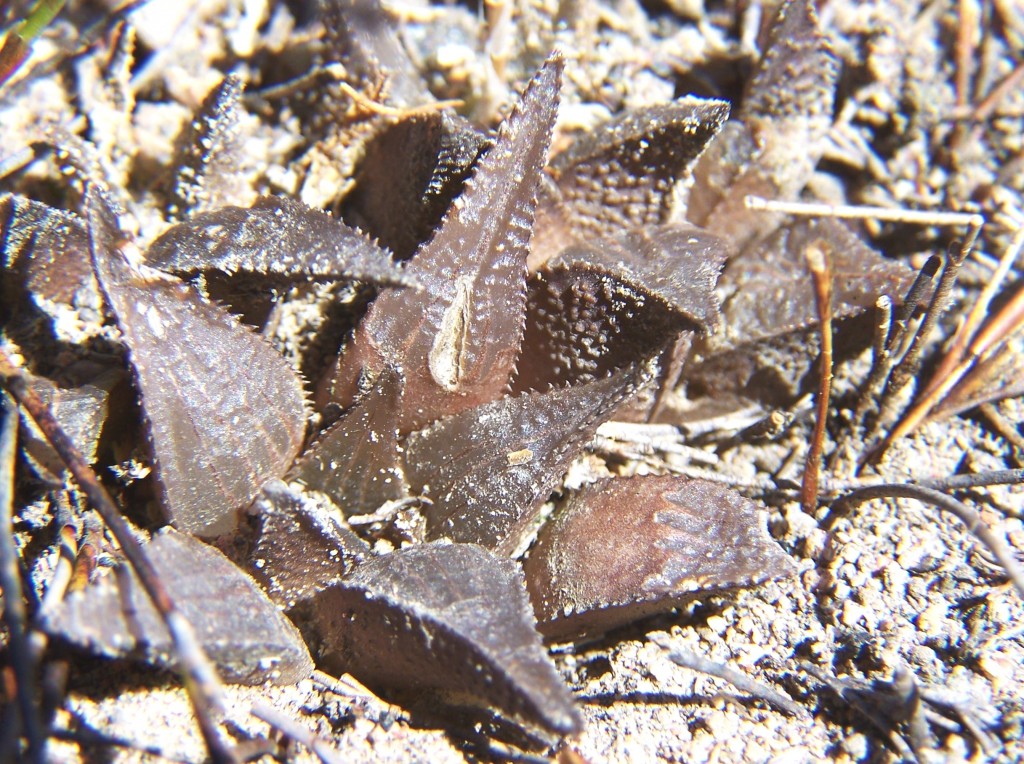
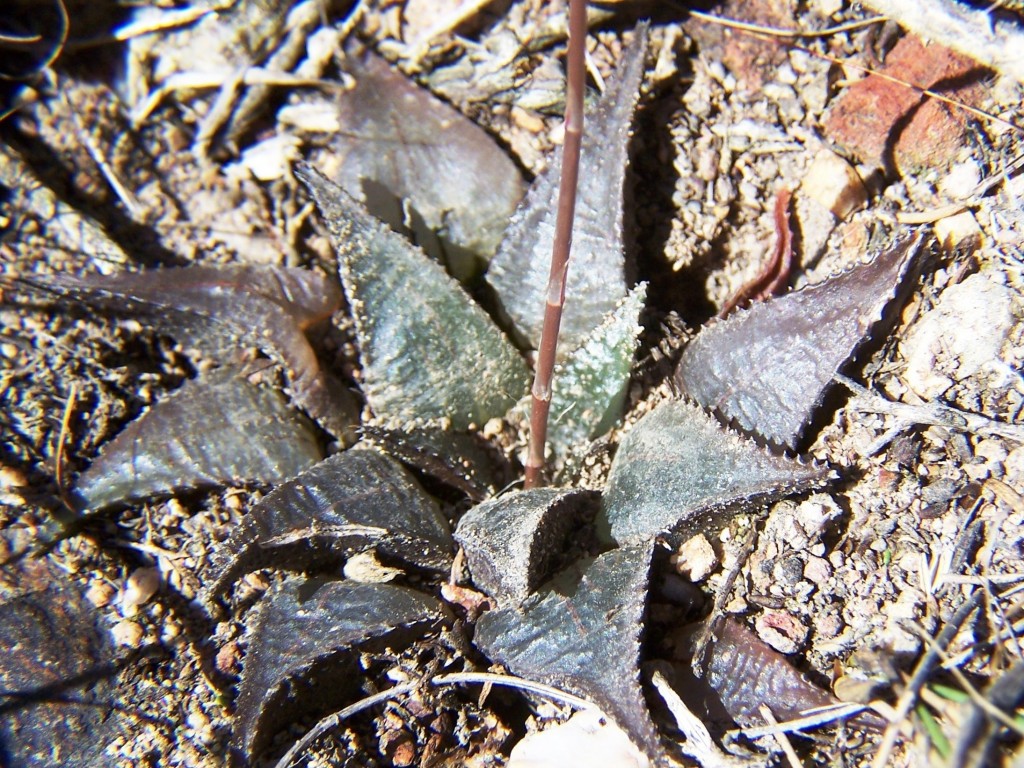
3. MBB7626 Diamant Mid (Figs 5 & 6). This population is less than a kilometer east of the receding on a more eastern and thus cooler aspect. The plants are a little smaller, the leaves generally more erect and are a little more reminiscent of mirabilis to the southwest in that spines are better developed on the margins and surfaces than in the case of classic ‘maraisii’ (I am trying to show that ultimately there is no infallible distinction).

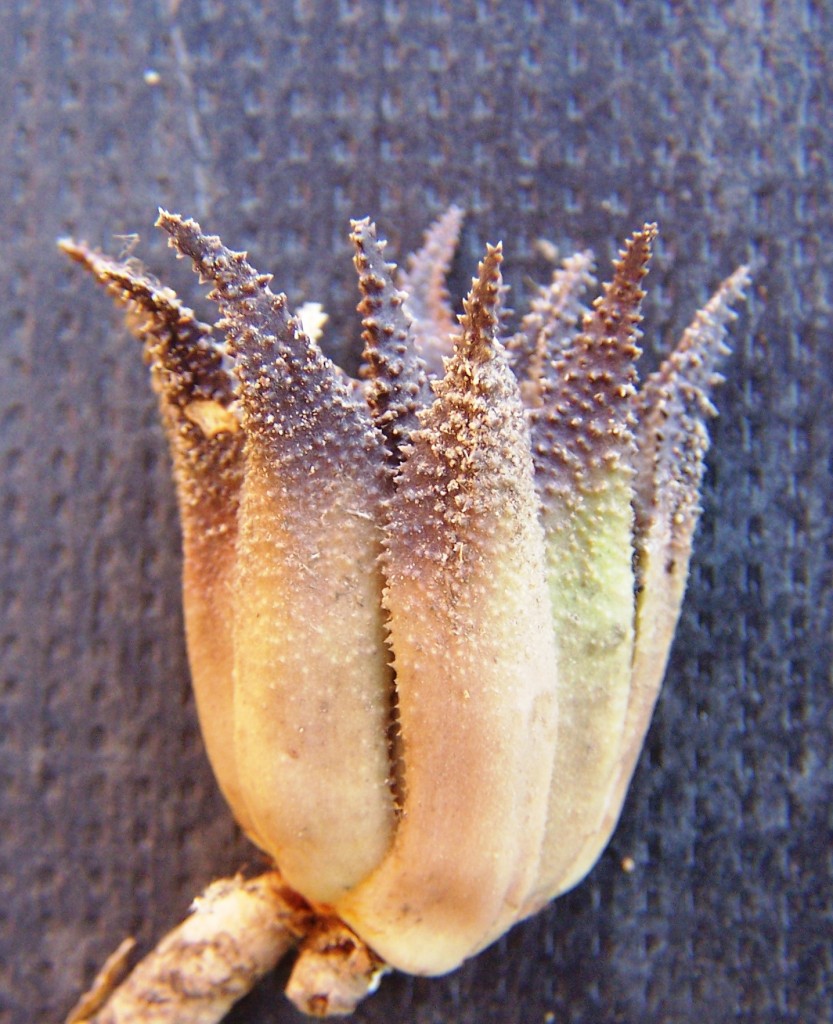
4. MBB7718 Diamant E (Figs 7, 8, 9 & 10). This is a huge population on a lower elevation than the preceding and the skeletal habitat is significantly different. It is on the interface of the Felspathic sandstone and shales and siltstones of an older formation while a strong vein of quartzite transects it. In addition there is evidence of an eroded away, and later, ferricrete deposit. The plants are also extremely variable, reflecting the range of divergent surfaces although generally much smaller than preceding. Leaf surfaces are mostly roughish.
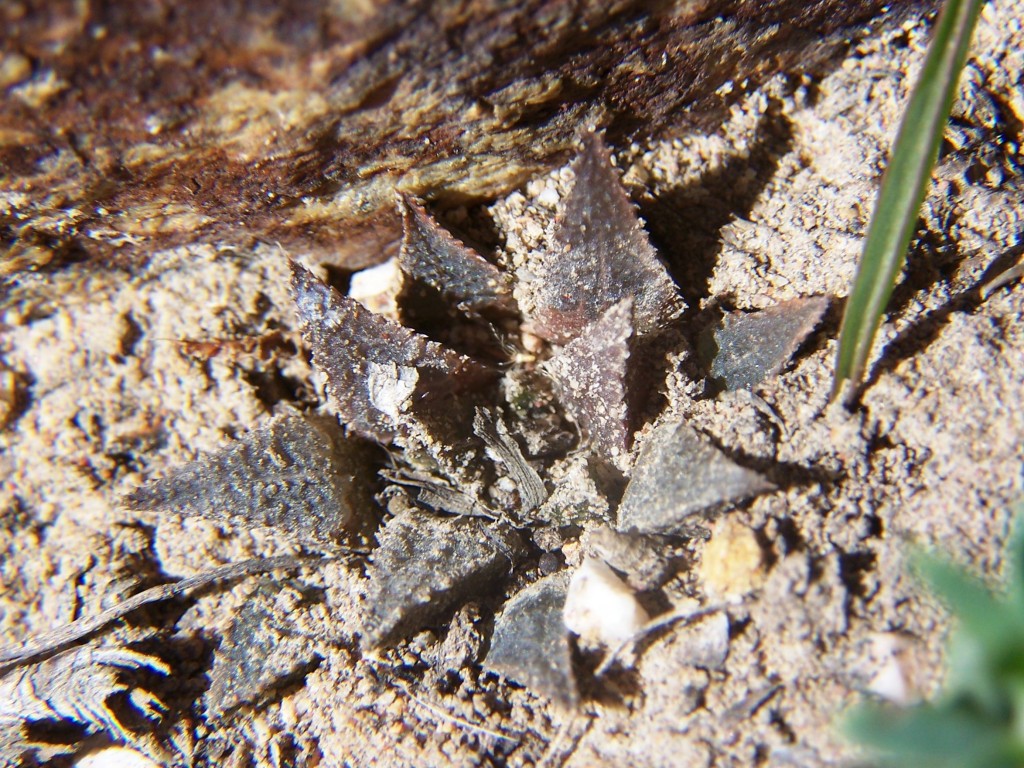

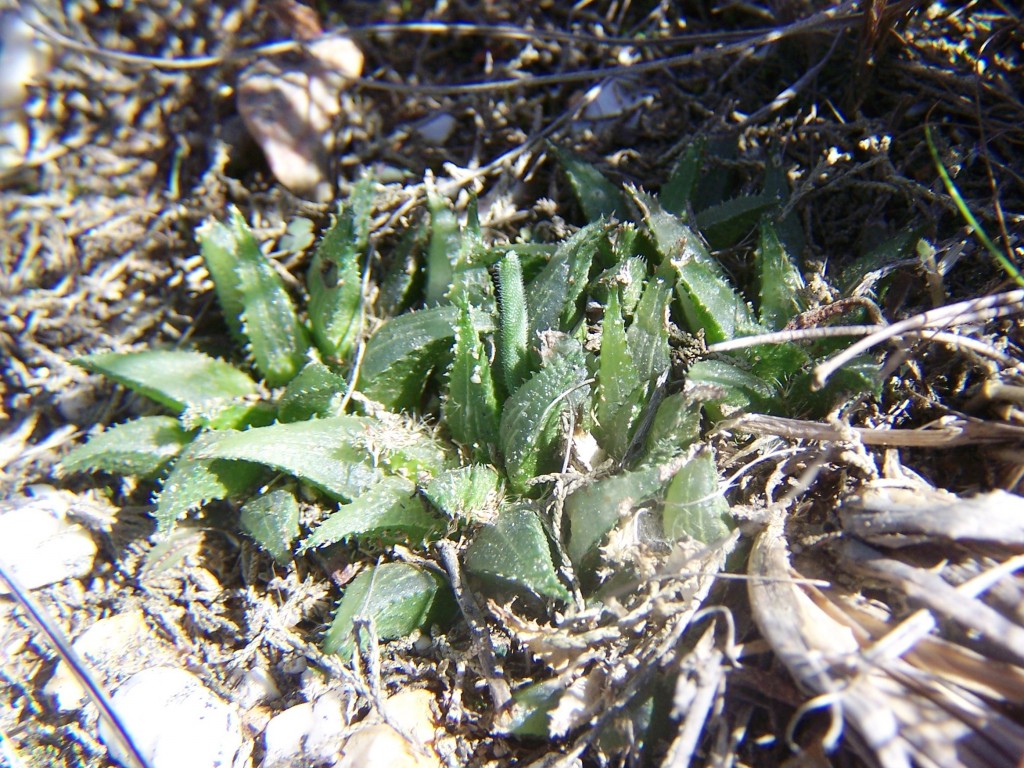
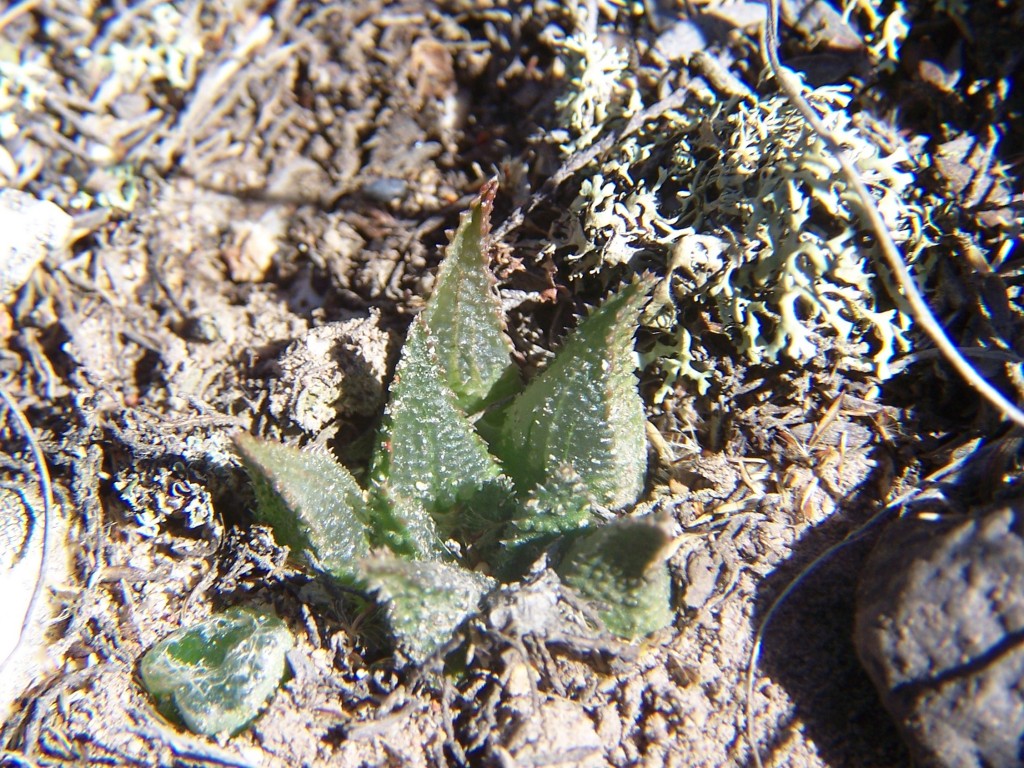
5. MBB7633 Luiperdsberg (Figs 11 & 12). A small population quite high up on a slope of felspathic sandstone. These are small plants and because of quite a grassy habitat the leaves are a little elongated generating the range of forms that I have generally assigned to a little understood or known range of plants and populations in H. ‘heidelbergensis’ Smith.
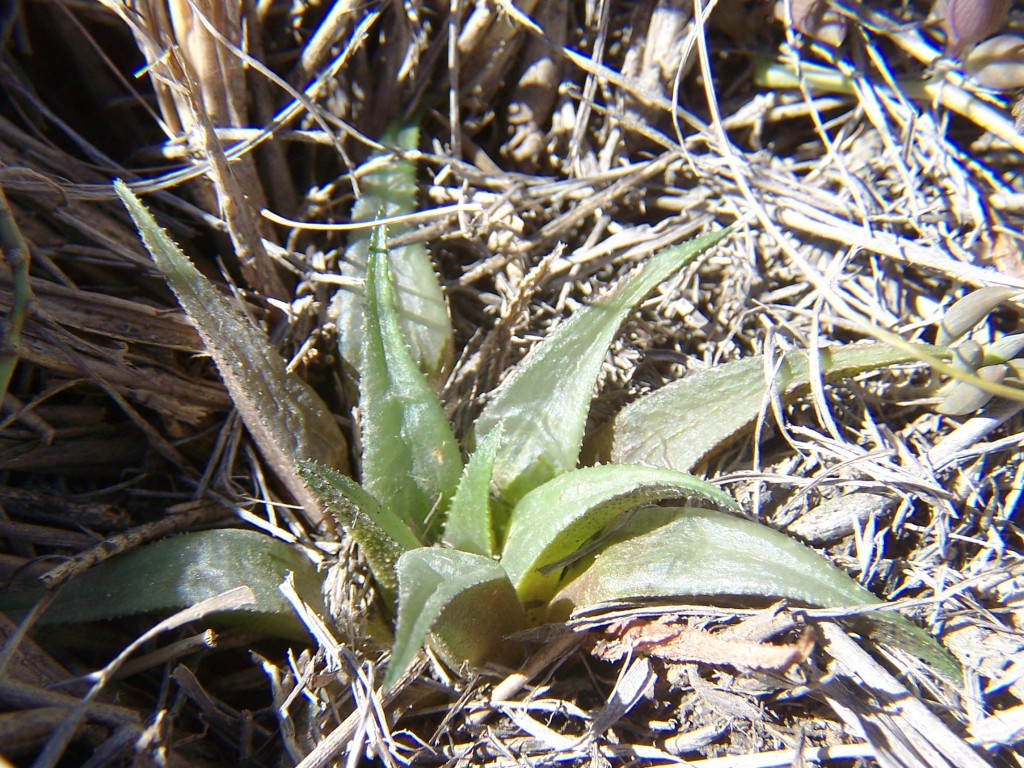
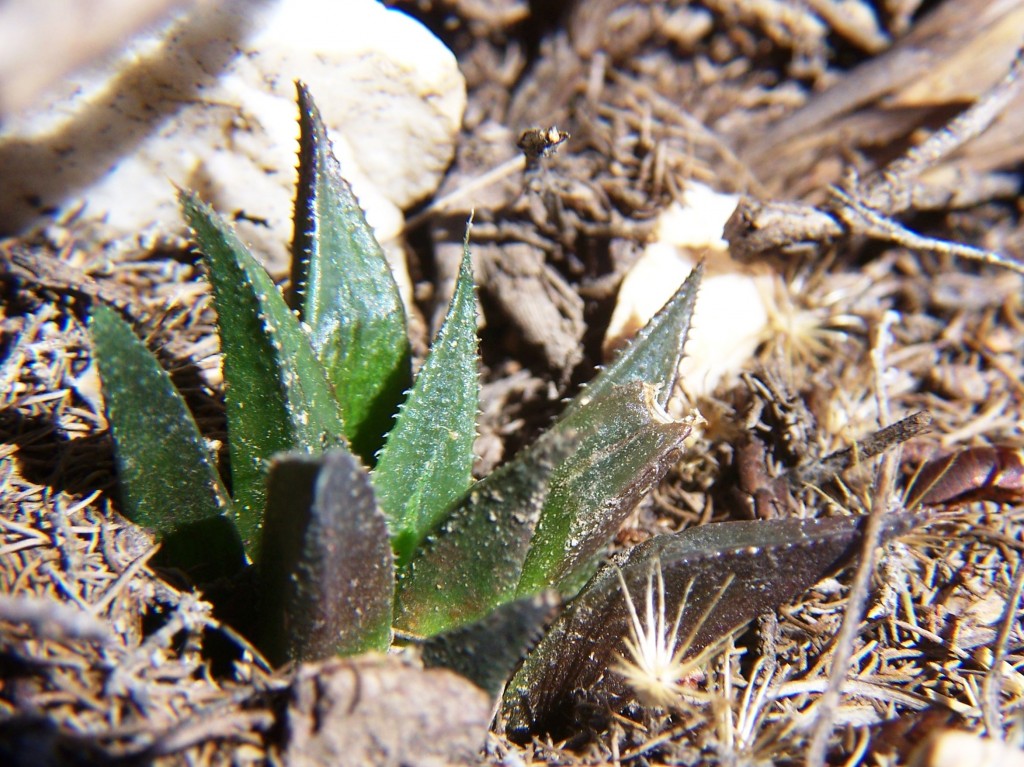
6. MBB7719 Dagbreek (Figs 13, 14, 15 & 16). An established population in felspathic sandstone but marginal to shale and siltstone. Very grassy but with occasional rocky ridges so that the plants are concealed in grass tufts or wedged in crevices. The plants are moderately sized to 60mm diameter and differ in that many have a rather smooth surface with corresponding finer and more closely spaced marginal spines. Some plants develop a shiny opacity about the leaf tips that suggest surfaces perhaps comparable with the smoothness of the H. retusa complex.
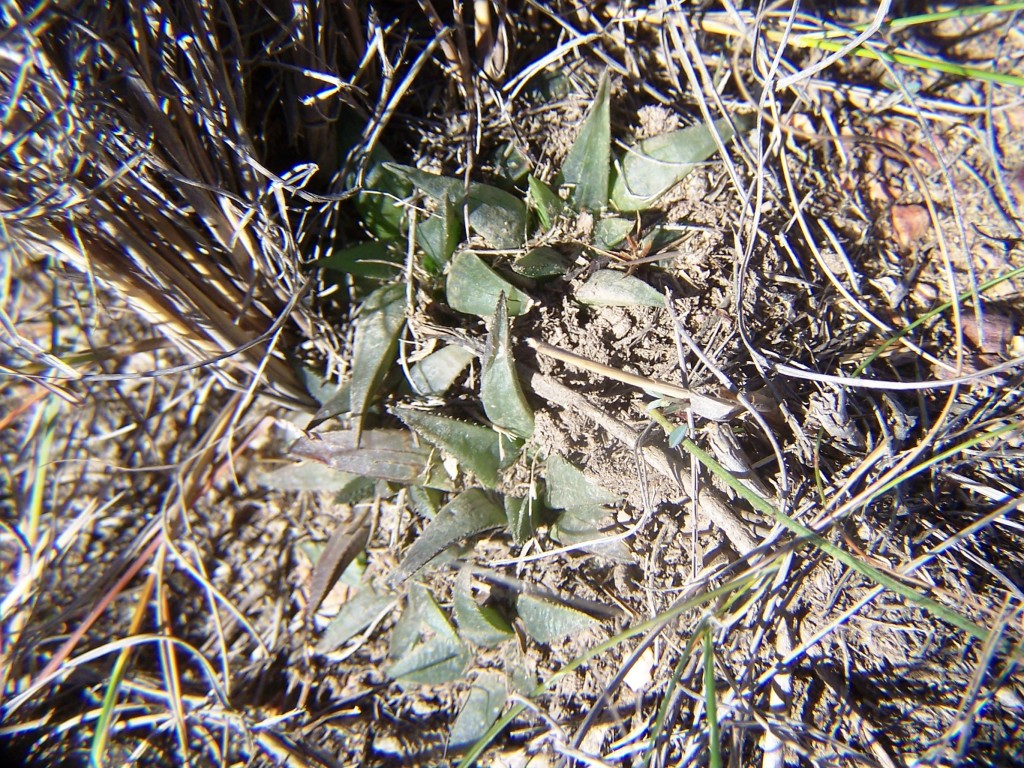


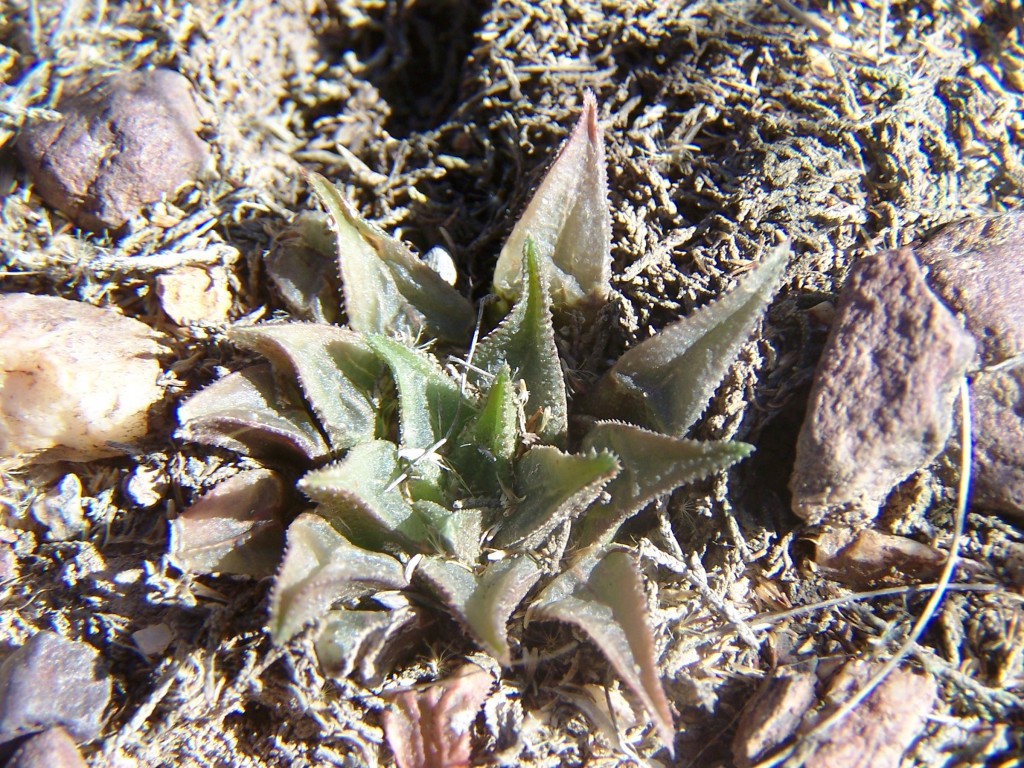
7. MBB7704 Bontebok Park (Figs.17, 18, 19, & 20). There is an earlier collection (6644) from the ferricrete/shale interface alongside the N2 highway near the northeastern corner of the park, which I considered belonged in a series of five populations that seemed to be neither H. ‘maraisii’ nor generally accepted H. mirabilis. It is on ferricretes but there is some problem how to relate this apparent river terrace gravel with the solid caps of the inselbergs to the east and west. There is nothing common in the general suite of species that could be described as Fynbos on the former and grassy Renosterveld on the latter. The plants are moderate in size; surfaces can be quite rough with a tendency to spination, and the marginal spines quite coarse. Leaves erect or spreading.
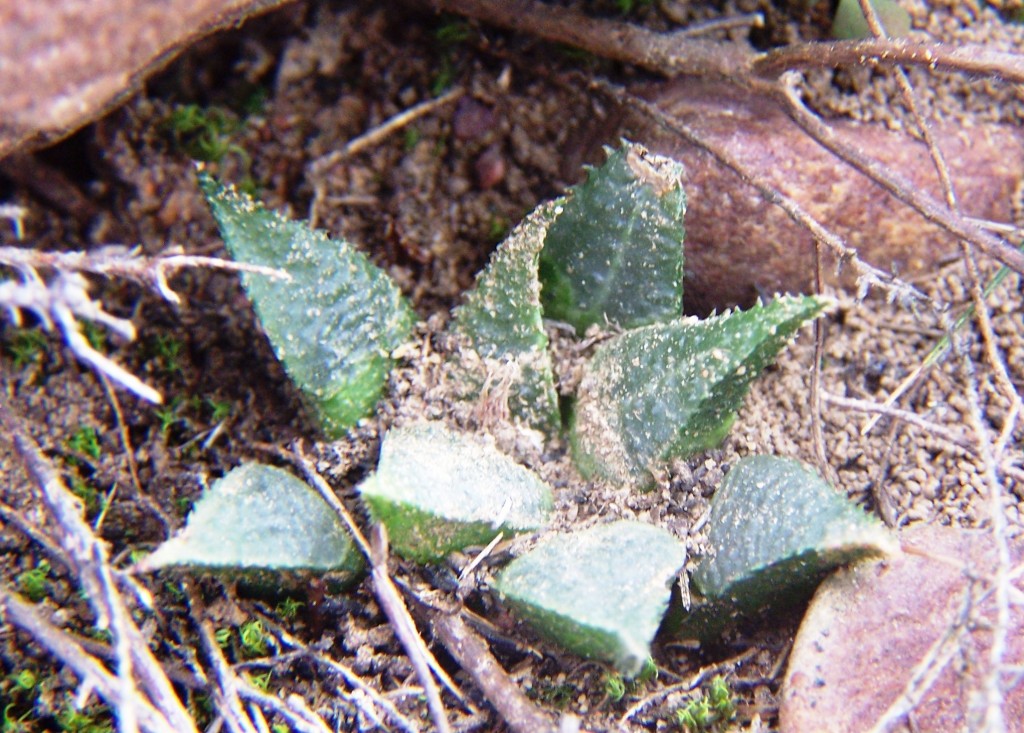
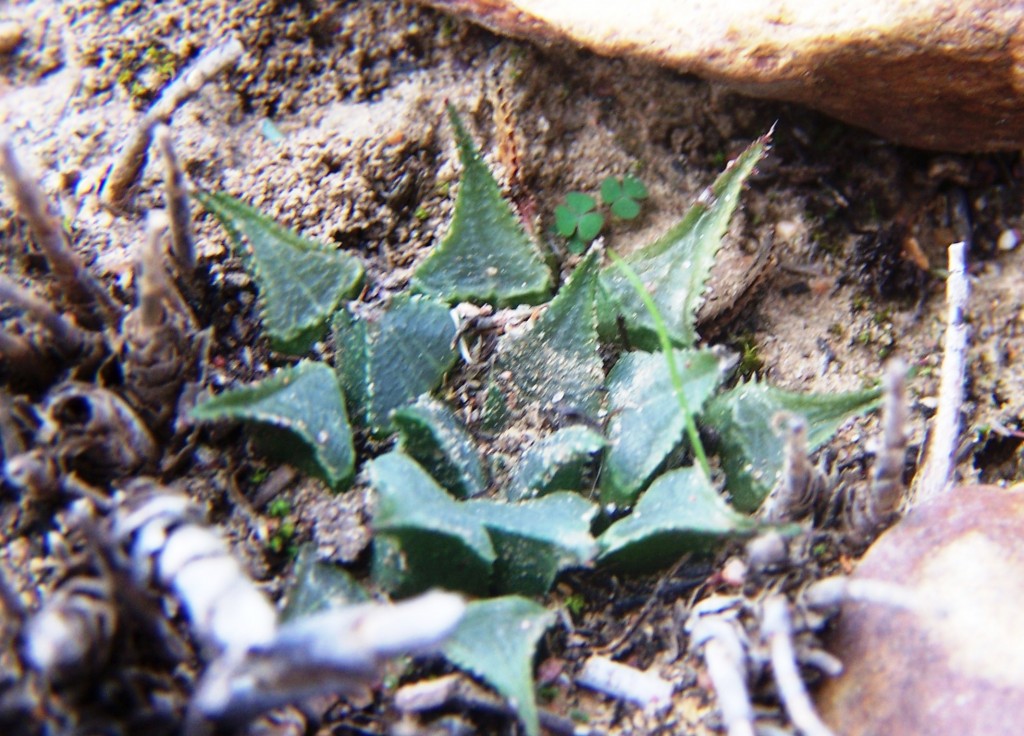
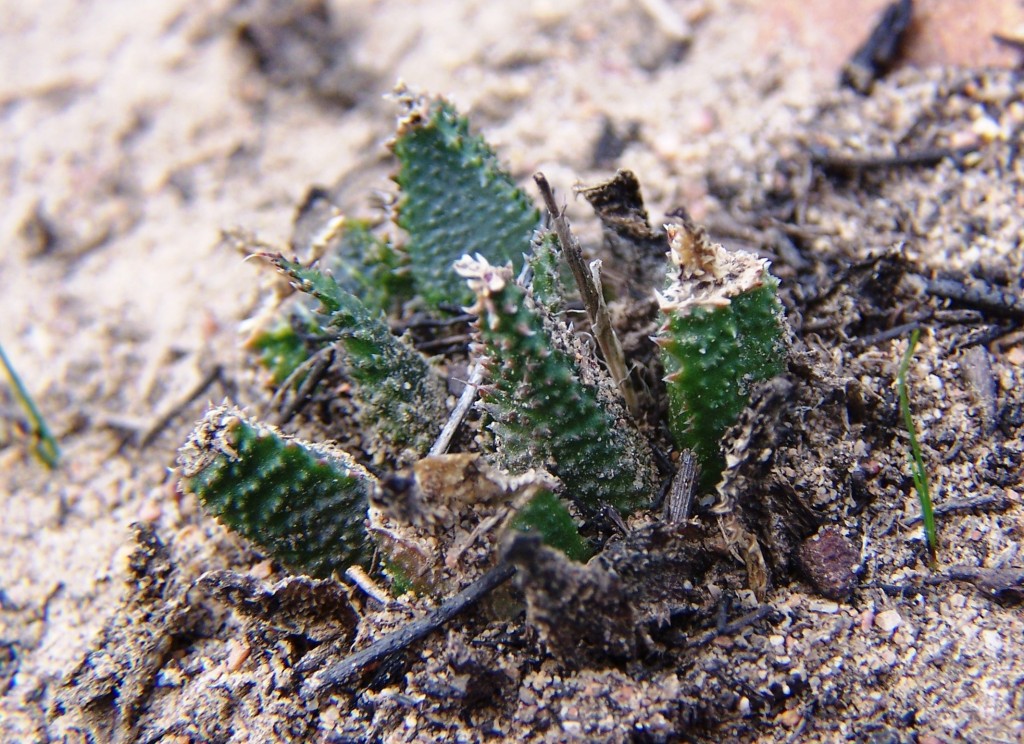
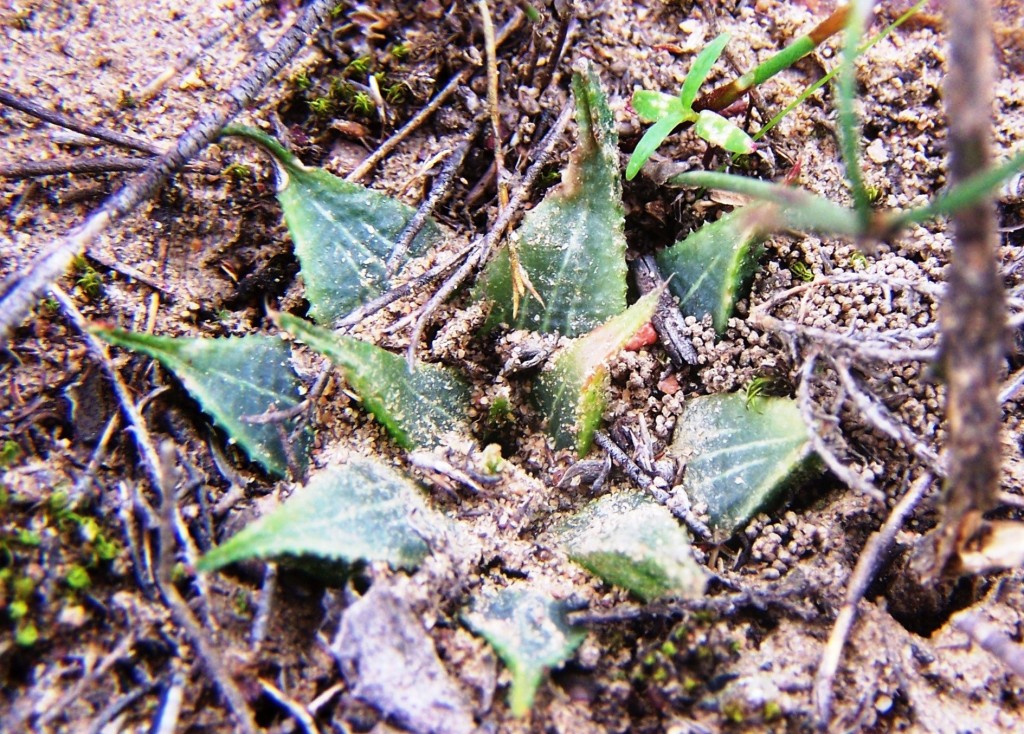
8. MBB7705, 7706, 7713, 7714, 7715 Uitvlugt (Figs 21, 22, 23, 24, 25, & 26). These are five quite independent populations on the one farm that is unusual in that it seems to be on predominantly an earlier variant of Cenozoic ferricretes. The plants are generally related to H. ‘atrofusca’ with rounded leaftips and roughish surfaces. The actual habitats are all different in respect of surface detail and associated vegetation. The plants vary in size between the different populations from small (30mm diam) to large (70mm diam). In the one site where the soil is whitish bentonite, the plants are small and also have a curious similarity of color to that of the clay and the associated plant Gibbaeum haaglenii (austricola).
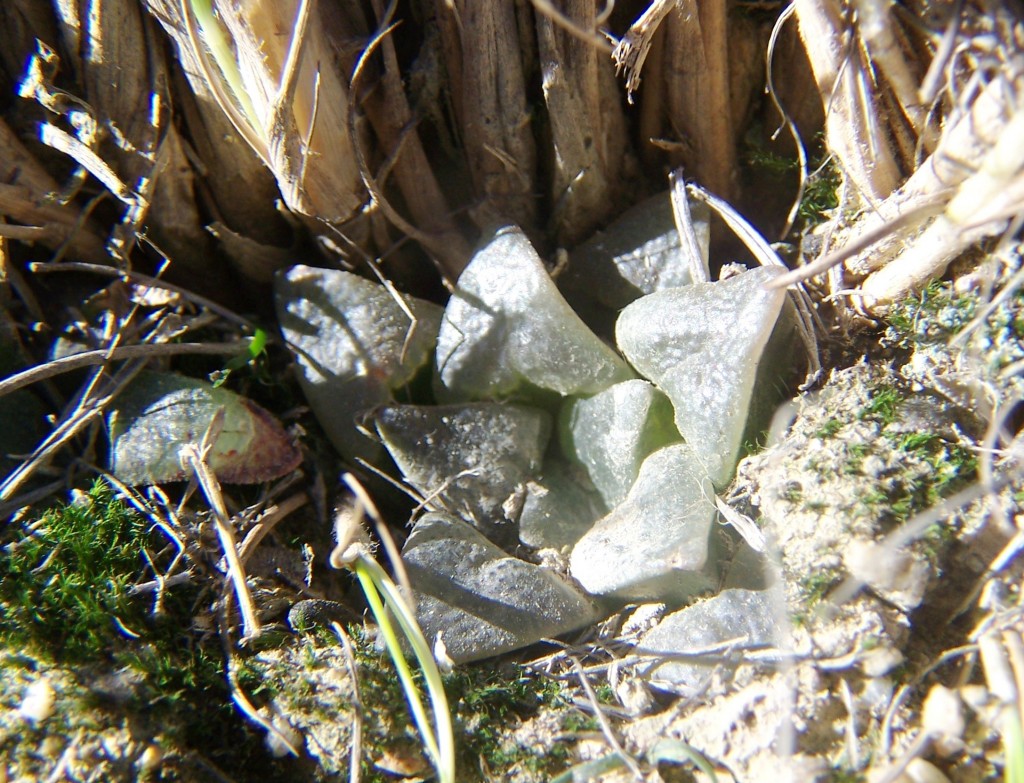
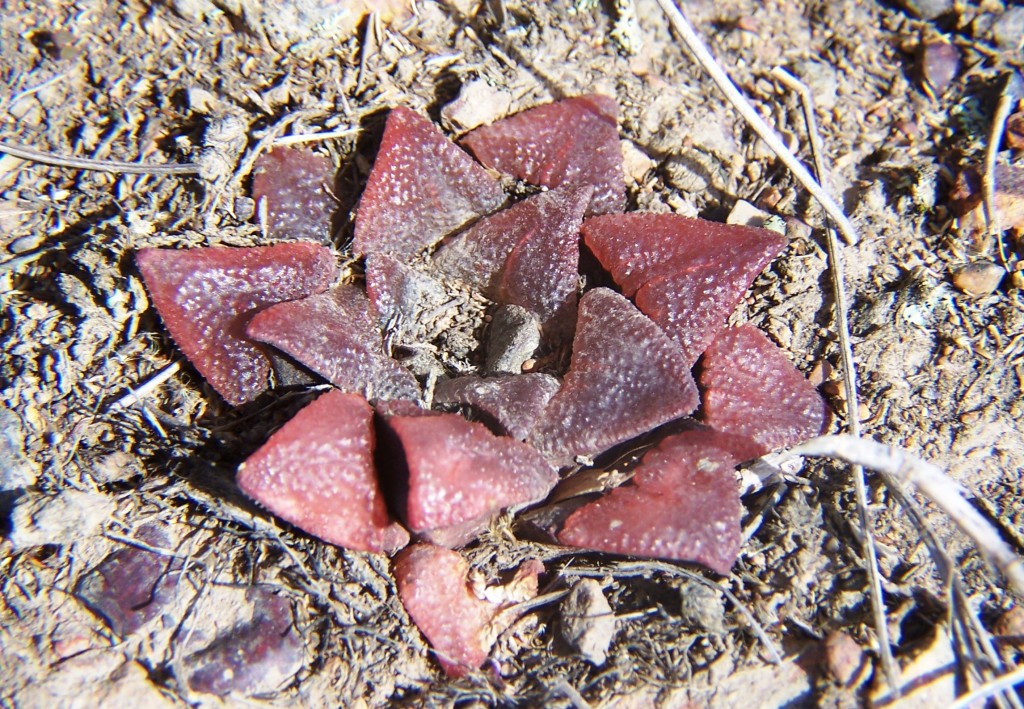




9. VA-RW07-27 (Figs 27, 28, 29 & 30). This population located by M Mougin, was reported to me by D. Van den Abbeele. It is much closer to Heidelberg and obviously in a ferricrete related habitat. The plants are all very ‘atrofusca‘-like with some evidence of the pointed leaf-tips that would have been ‘magnifica’. The surfaces have the slightly riffled texture that one associates with ‘atrofusca‘ rather than the tendency to roughish surfaces or almost spinescent tubercles associated with, but not peculiar only to ‘magnifica’.
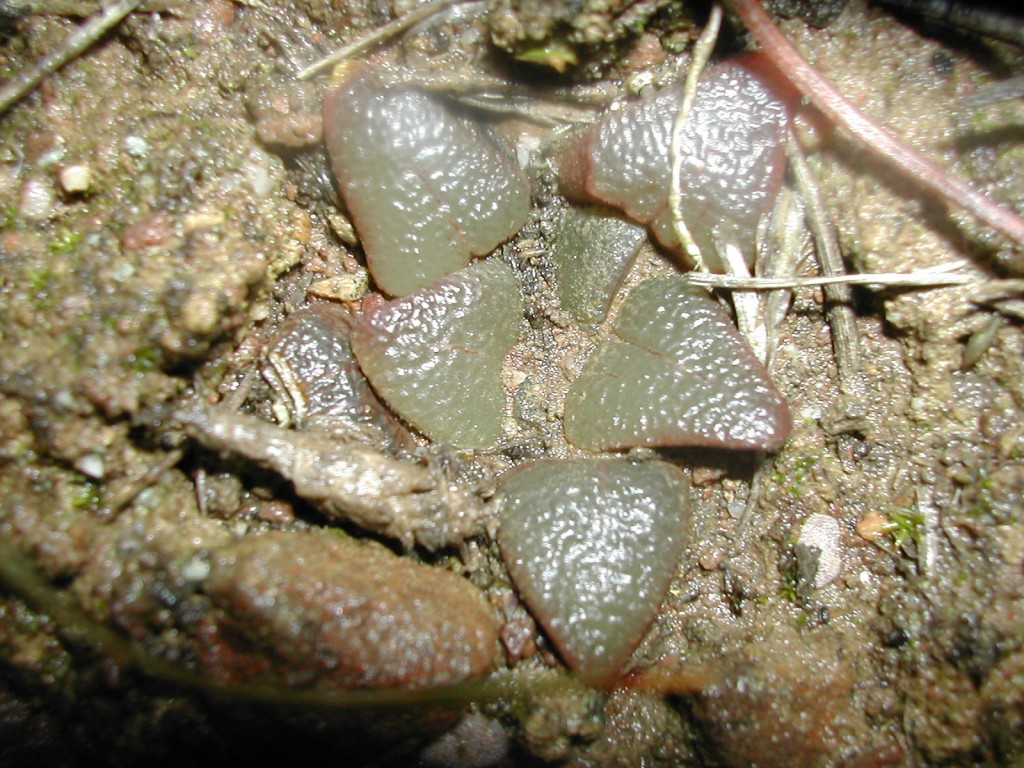
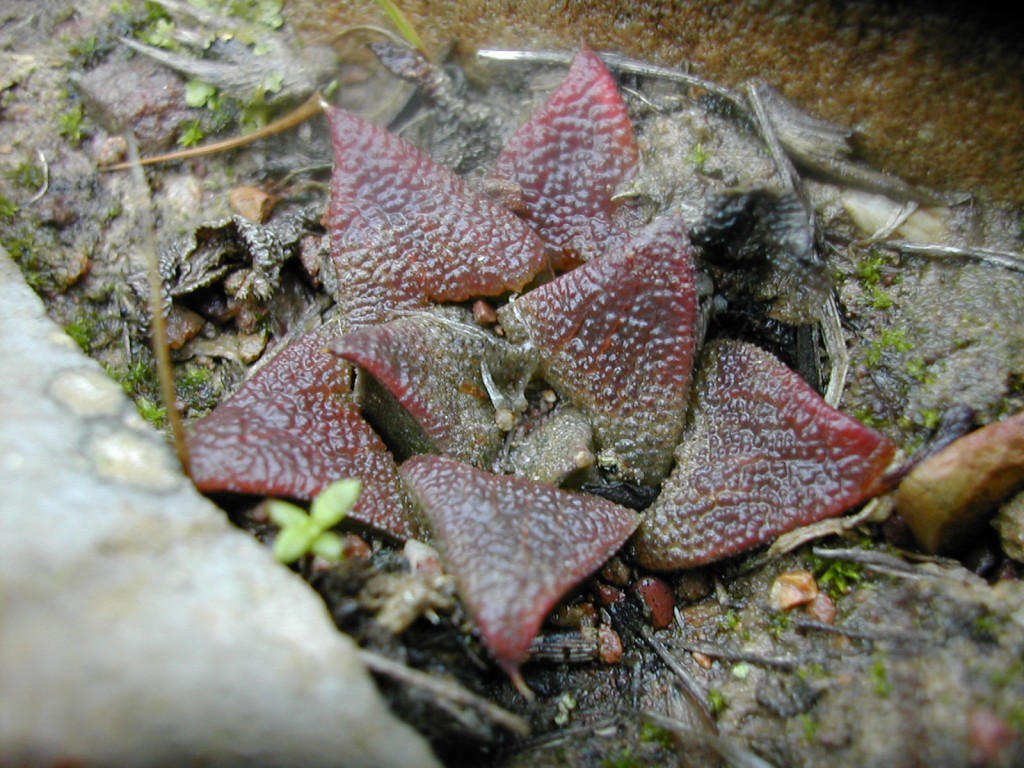

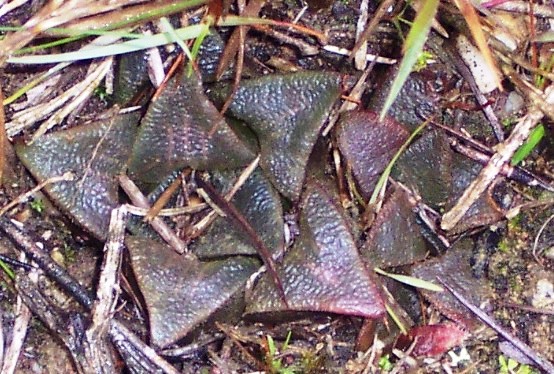
10. MBB7728, 7729 Lilliendal (Figs 31, 32, 33, 34 & 35). The significance of these two populations must be emphasized. The place is the Karringmelks River southwest of Heidelberg. This river drains into the Slangriver that flows then southwest into the Breede River. It is quite a different drainage basin to the Klip and Duiwenhoks rivers that drain the area north and west of Heidelberg and enters the sea south of Heidelberg. Matjestoon and the origin of H. ‘heidelbergensis var. toonensis’ is south of Lilliendal and on the same drainage system. The plants would at the time have made it difficult to imagine H. ‘heidelbergensis’ as a discrete system, and these plants force a direct comparison with H. ‘maraisii’, if that system could be generalized. The plants are small, dark-green, rough and with a degree of spination on the surface tubercles. Surfaces may be opaque or translucent. There is a striking resemblance of the seedlings to H. floribunda. The populations are about 1km apart. Both are on Bokkeveld but at the second population it is curious to observe that the plants are not on the ferricrete only meters away.
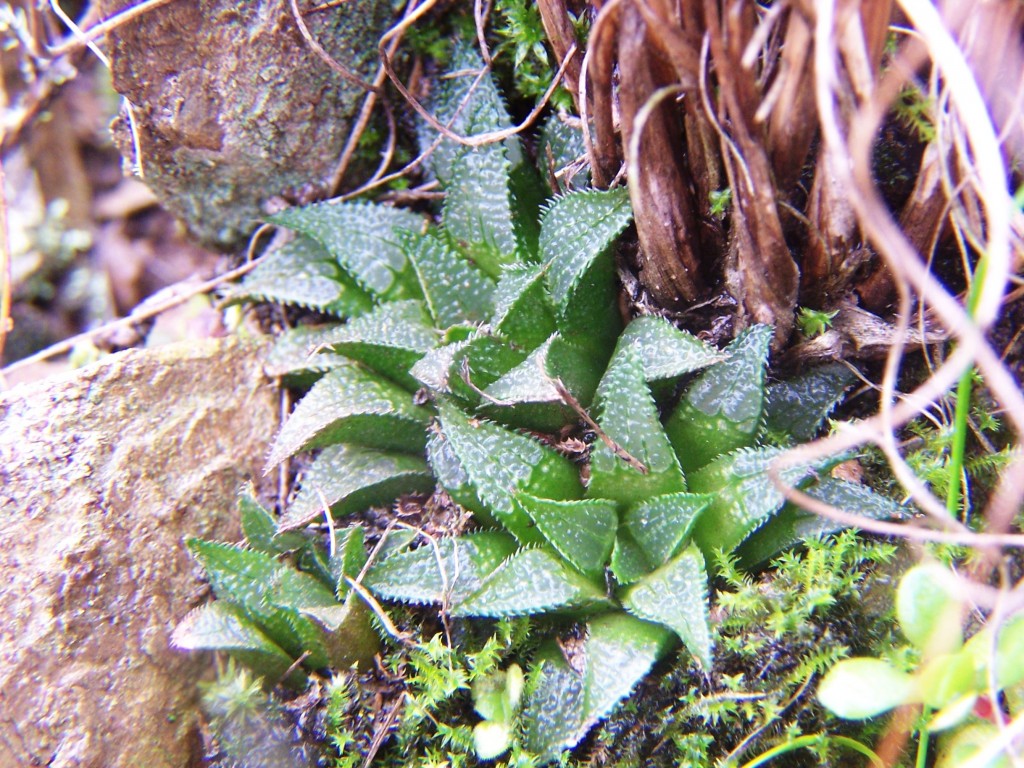
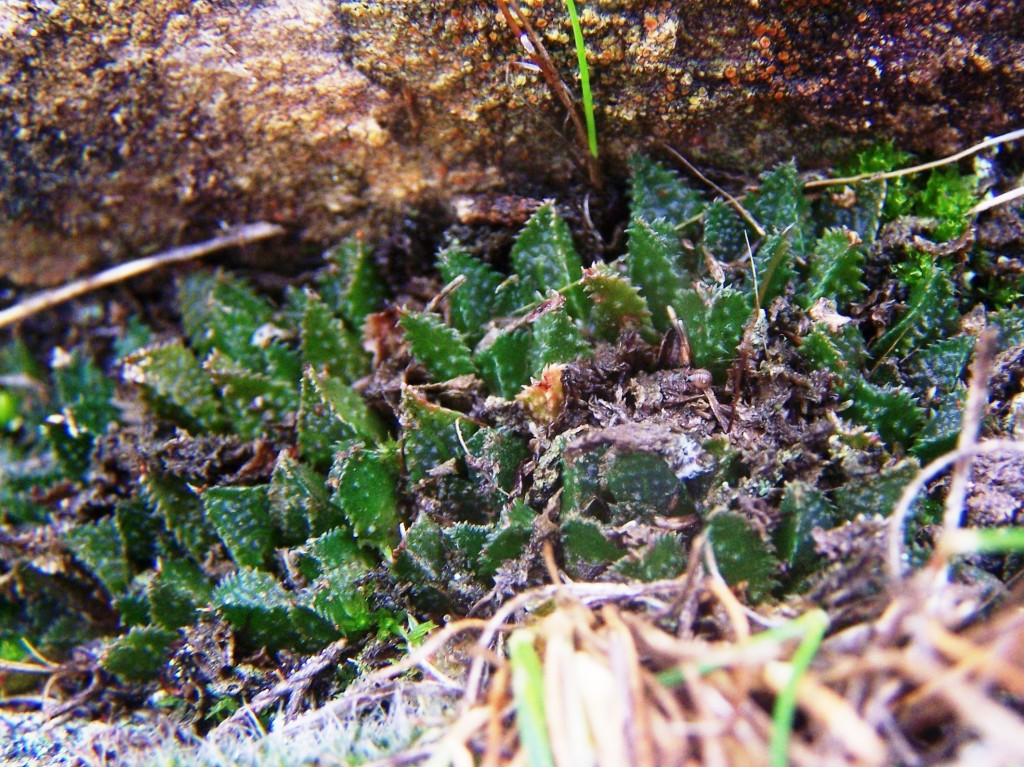
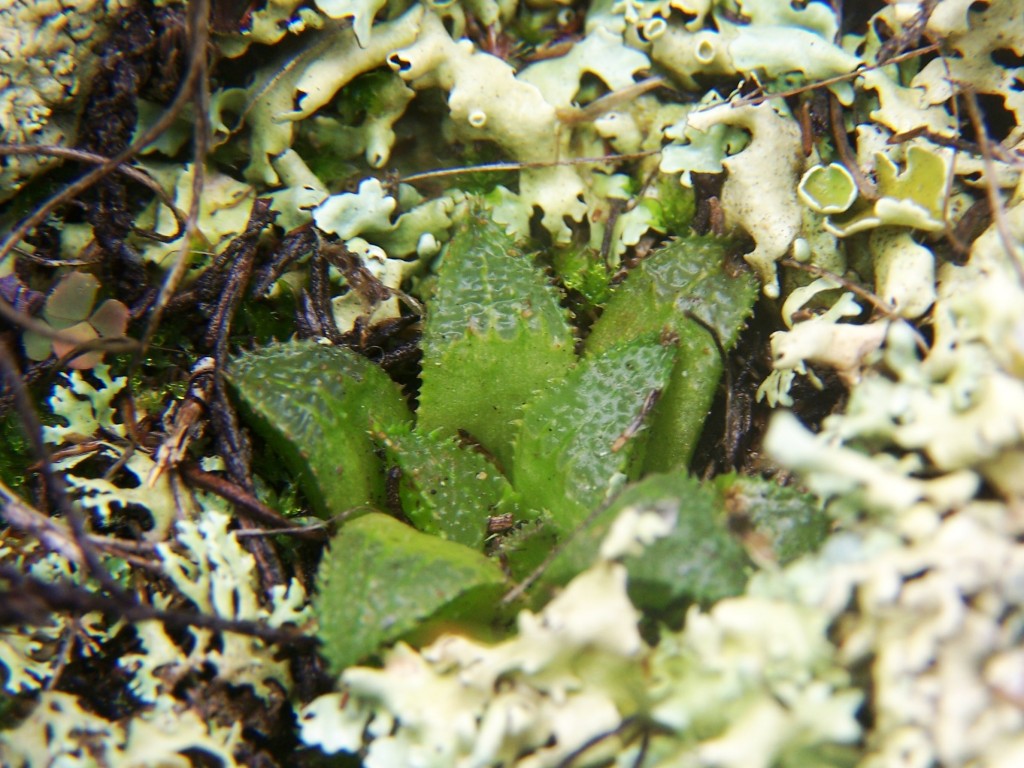
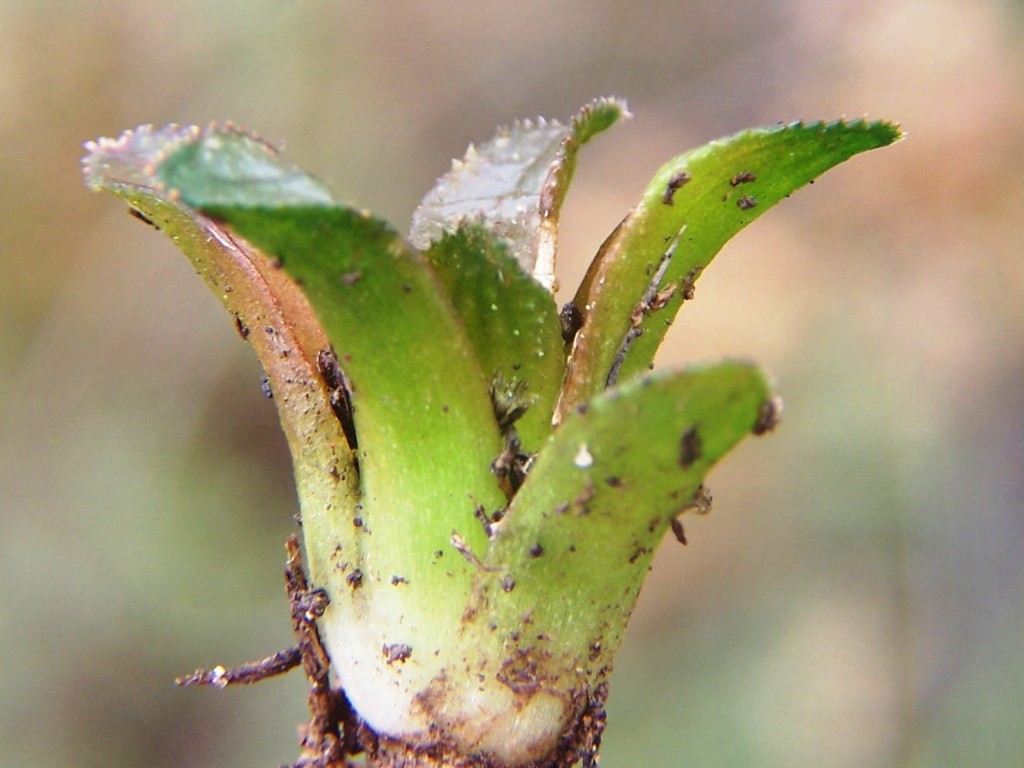

11. JDV87-3, MBB7165 Matjestoon(Figs 36, 37 & 38). This is one of the original populations known to G. G. Smith and it is an uncomfortable fit anywhere on account of the length and spiny-ness of the leaves. That the plants were placed in ‘heidelbergensis’ is a reflection of the doubtful and composite nature that the species gained by default. There is a semblance of similarity to H. rossouwii but what may be more notable is that at Dassieklip to the southeast there is a very aberrant population that is assigned to H. floribunda simply for want of a more likely category. I say this is notable because in my field observations of Haworthia there is a very strong and predictive geographic continuity between populations. This is evidenced in this general discussion.
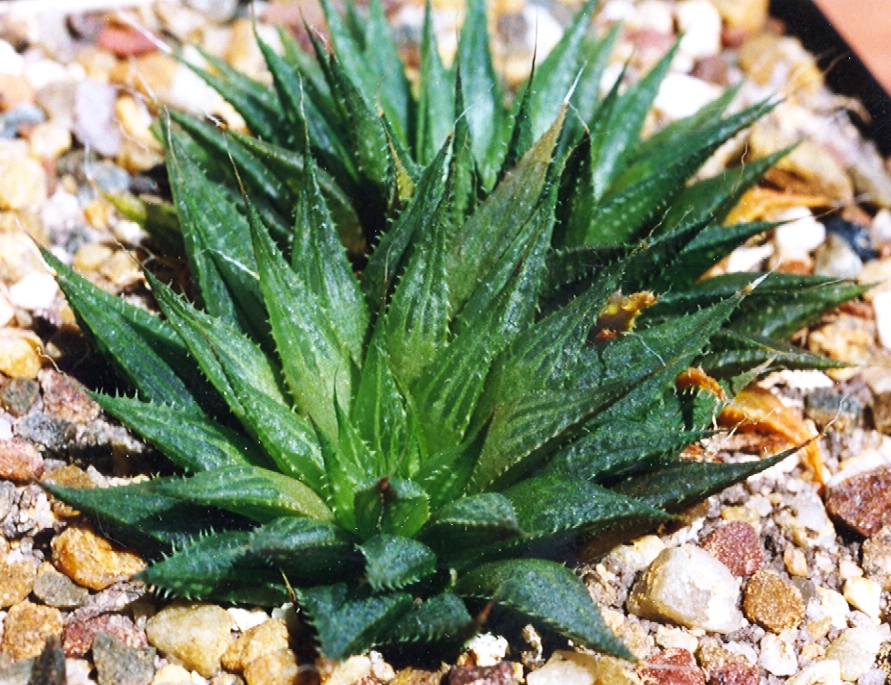

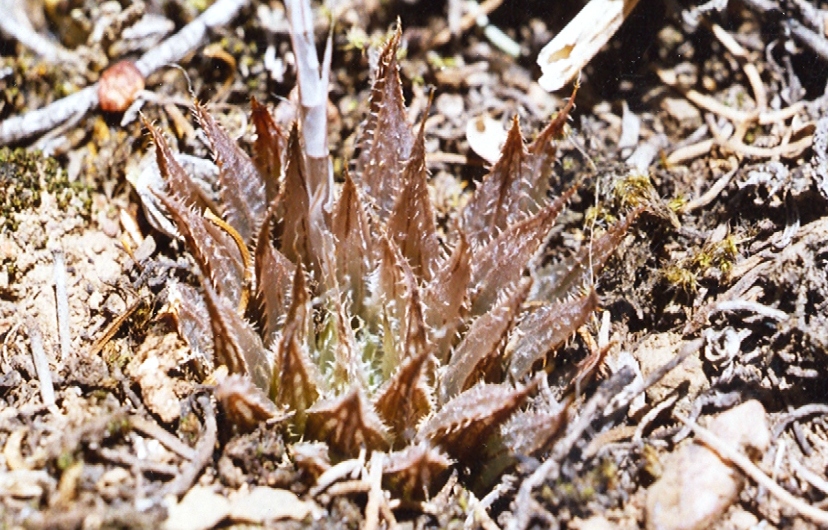
12. MBB7736 Koppies (Figs 39 & 40). These are small dark-green plants with strongly deflexed leaves and a little unlike an earlier record from 2km west (MBB6879 ex E. Esterhuizen) where the plants have more pronounced surface tubercles becoming quite robust and dark in cultivation. The habitat is among white quartz occasionally associated with ferricrete.

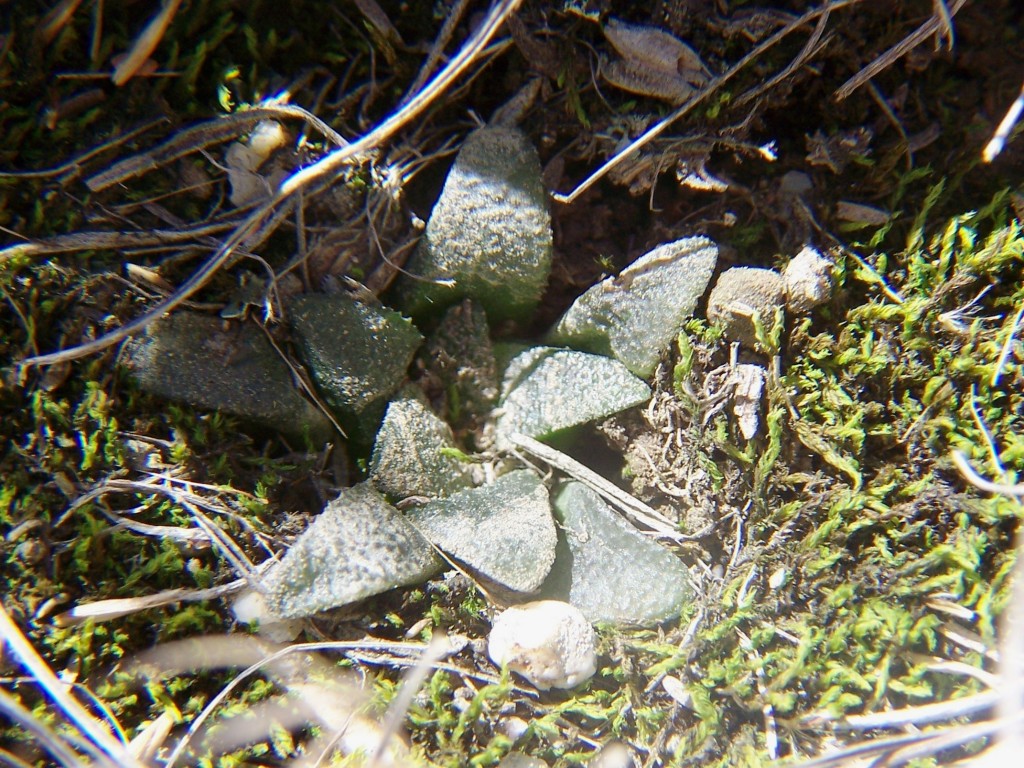
13. MBB7723 Stuurmanskraal (Figs 41 & 42). These rank among what might be regarded as the general body of H. ‘maraisii’. Small, dark roughish plants with strong evidence of floribunda in the way the leaf-tips tend to be flat, twisted and rounded. The habitat is Bokkeveld shale.
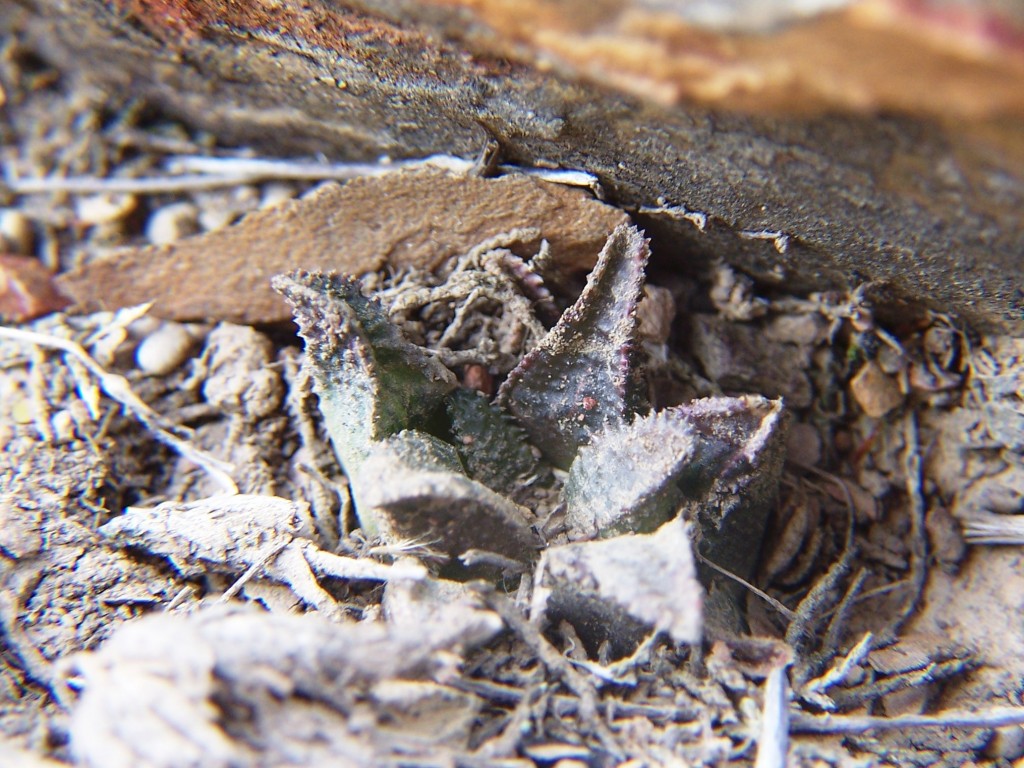
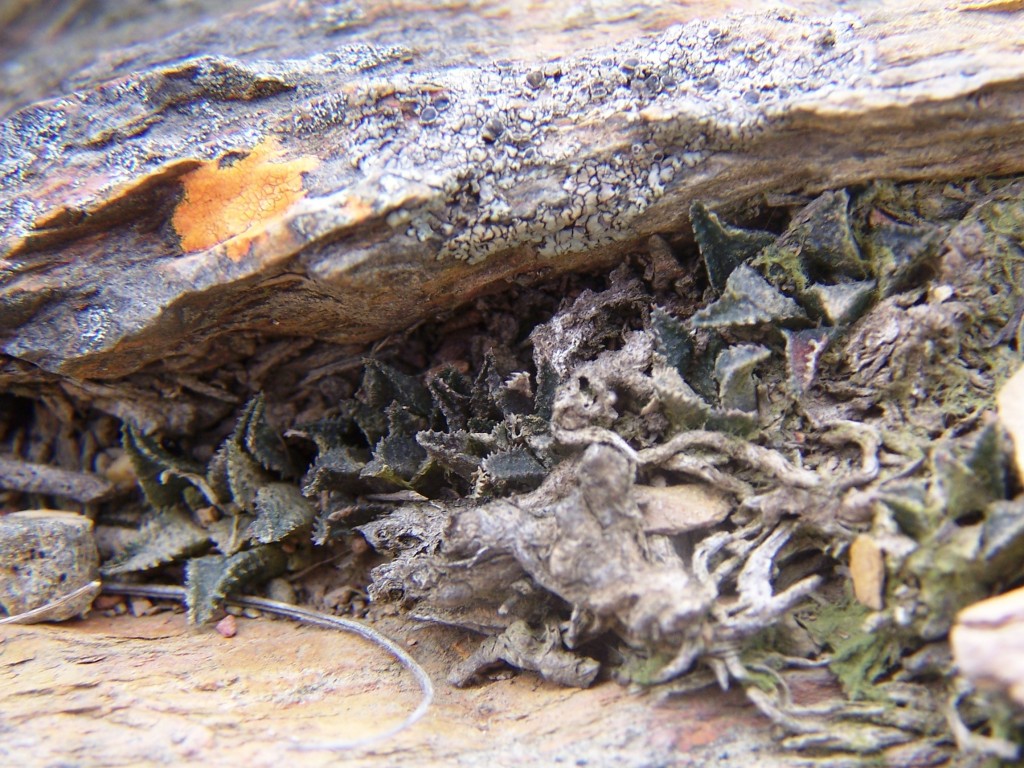
14. MBB7734 Stuurmanskraal N (Figs 43 & 44). This is a previously known population similar in its responses to the Koppies plants (MBB6879) that become quite robust and dark in cultivation. The habitat is white bentonitic clay that develops under the ferricrete sills from decomposure of underlying shale.
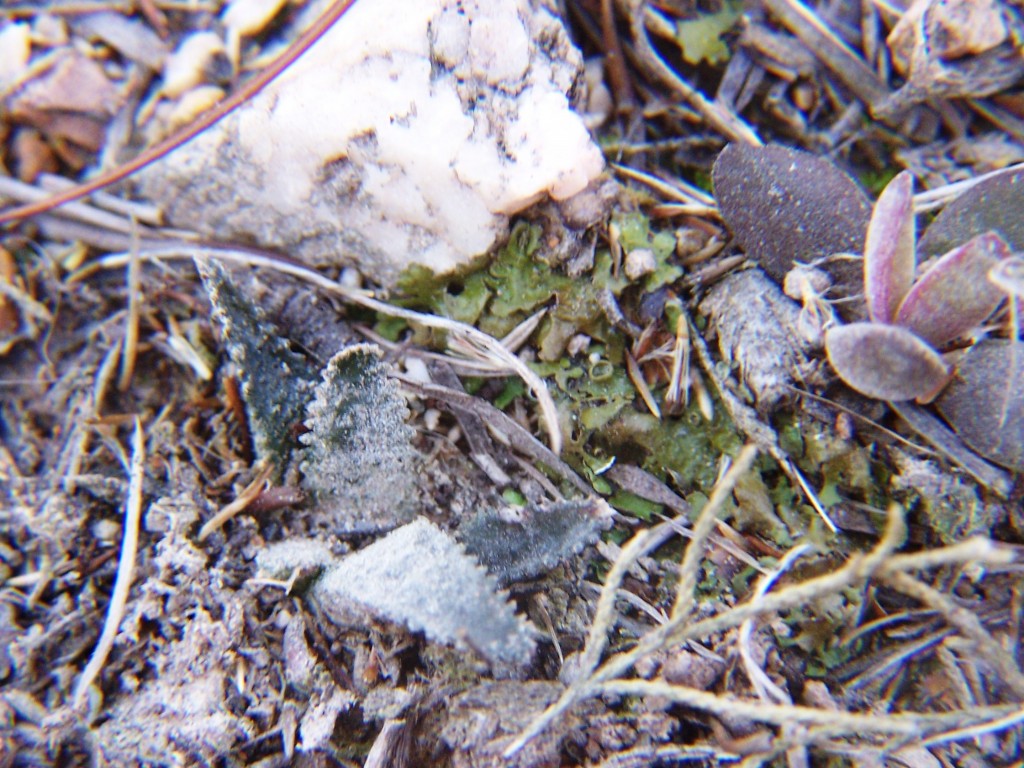
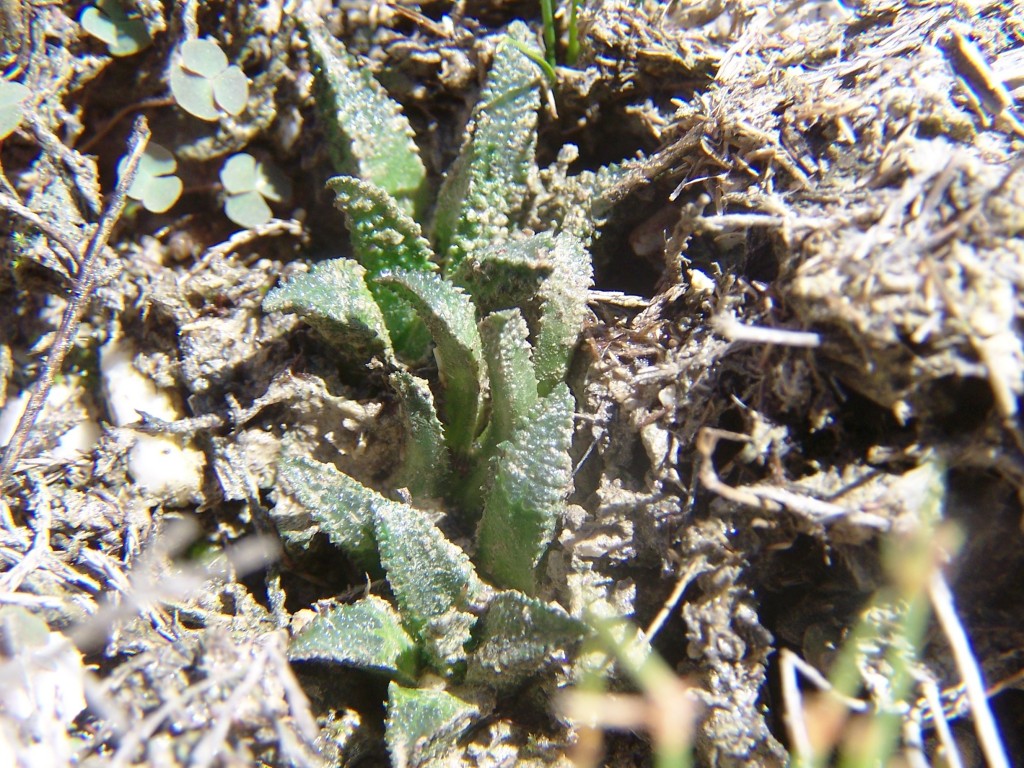
15. MBB7731 Oudekraalkop (Figs 45, 46 & 47). Finding this population at all suggests that there may be many more evading the eye. The plants are small and dark and completely hidden among dense but short vegetation on a rocky scree-like area. As in other populations one is compelled to look at every plant and consider its departure from a hoped for norm for the plants there. Three illustrations hardly do justice to the variability and this true for all these populations discussed here.
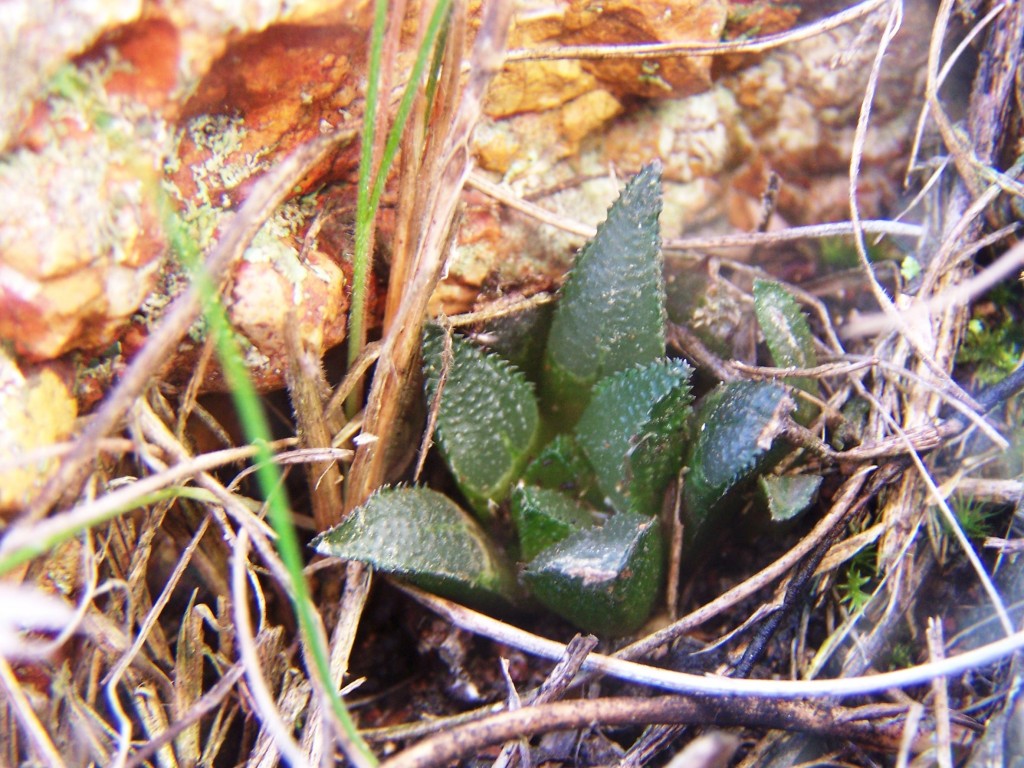
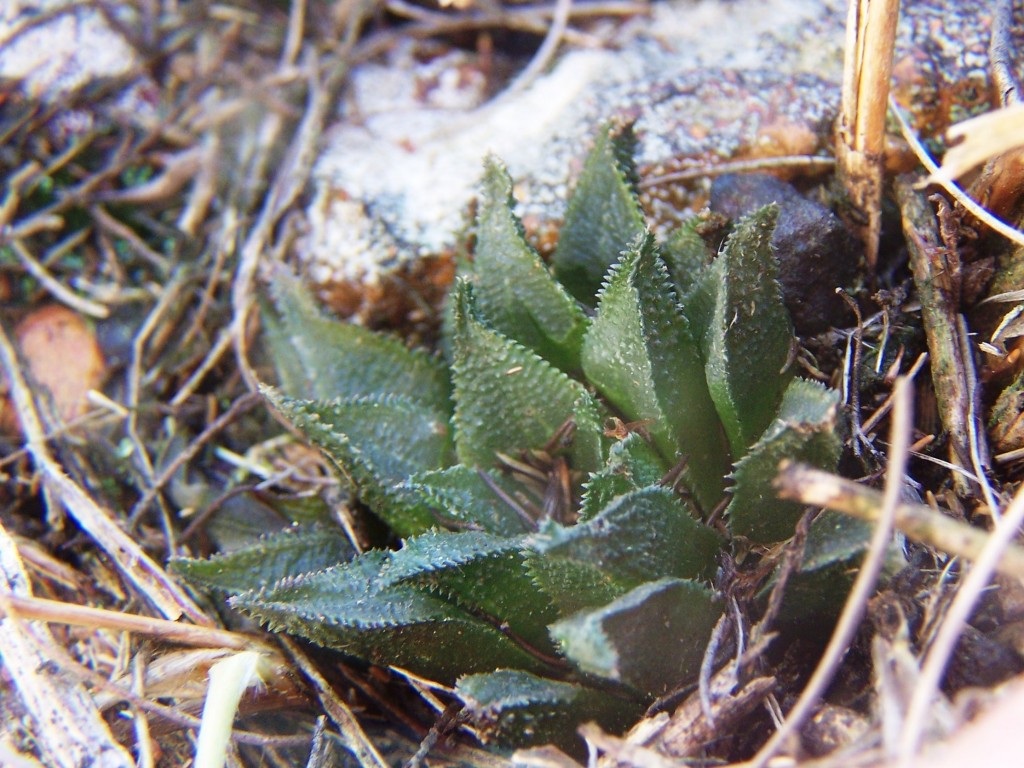
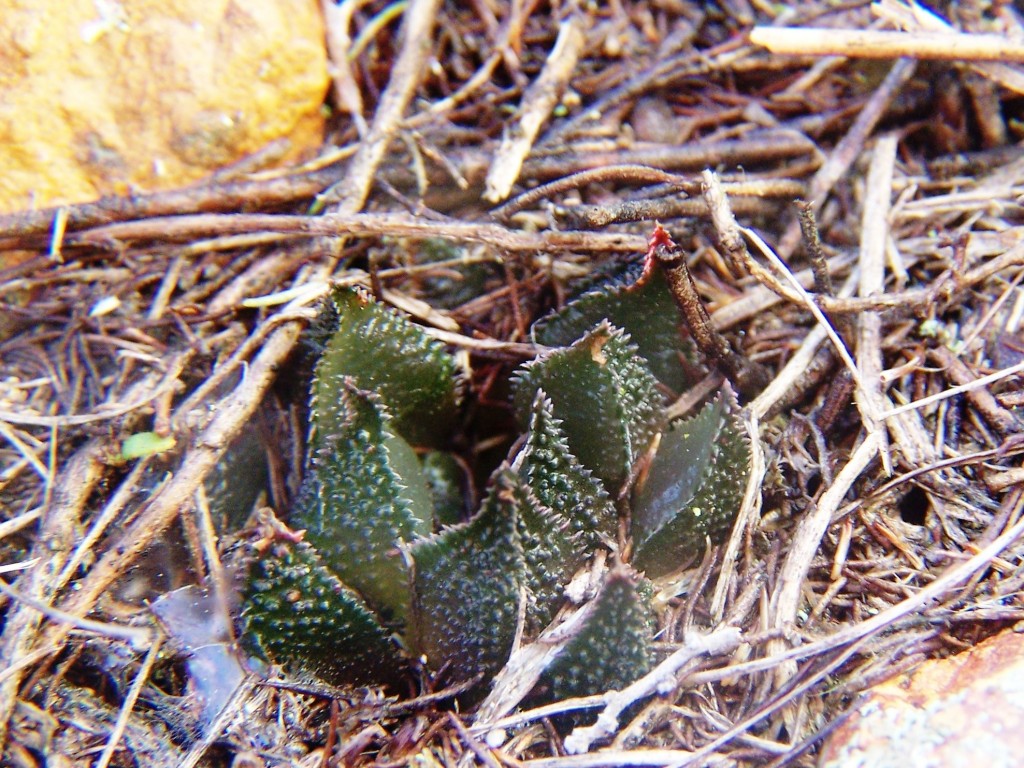
Conclusions
My despair over the years that I have been involved with Haworthia, is that the classification model and nomenclatural system we use, does not seem to allow me the freedom to express what I have seen and experienced. My argument has been that we are dealing with a biological system in which things that seem different are the same; and conversely things that seem the same are different. It is not a problem to apply a formal classification system except that a ranked or tiered system suggests quantum differences too, and this is simply not true. The greater problem is that most plant enthusiasts, and those who feel strongly about classification and names, confuse the reality of the sameness that suggests ‘species’ with the sameness that plants of different species may exhibit.
It is with a source of considerable curiosity that I now take note that a taxonomist is one who classifies by appearances and a systematist one who classifies by evolutionary pathways. In truth I never considered that classification was anything but an attempt to accomplish both aims so that meaningful names could be established. The issue is clouded in complexity when it is considered that neither taxonomist nor systematist may be sure when a species is a species. Probably hence the observation that species (binomials) carry a reality they do not possess. My proposal, supported by the observations in this article, is that we adopt a far more informal and flexible approach to the use of all the names we now have at our disposal. This suggestion is also supported by an experienced taxonomist/systematist/botanist who wrote: “The informal system that I prefer allows for endless forms that are identifiable by their locality and do not clog up the literature. Essentially it is a reversion to the polynomials of the pre-Linnaean era.”
My contention is that the only rational classification of the above 20 populations is within a greatly expanded concept of H. mirabilis that includes H. maraisii, H. magnifica, and H. heidelbergensis. This corroborates the observations reported in the chapters in Haworthia Updates and specifically Chapter 6, Update 2,1:50-79 “How to understand H. mutica var. nigra”, and Chapter 1, Update 3,1:1-87 “H. mirabilis and the interface with H. maraisii”.
Acknowledgements
The population MBB7704 was shown to me by Ms. Tineke Kraaij of RSA National Parks Board. The concurring botanist is Dr John Manning, who has authored many botanical works and who is best known for his familiarity with the highly complex Cape bulb flora. Dr. Syd Rhamdani introduced me to the new direction that molecular biology is driving plant systematics. Gerhard Marx has been a great help in getting me to resign to the unrealities of popular taxonomy. Steven Hammer, considerably more successful than I have at adapting to the fact that our perceptions about many things are very different to that of others, helped me with the manuscript. Rhett Hiseman of Cape Nature, Jaap Viljoen, Henniie and Elma van Deventer of Koppies, the Odendaals of Dagbreek, Diamant and Dankbaar, Alfred and Andrea of Lilliendal, Dirk Papendorp of Uitvlugt, D. van As of Stuurmanskraal, Anna and Arno Steenkamp of Oudekraalskop (Anna’s Farm) are sincerely thanked for information and/or access to plants. ♦
References
Bayer, M.B. (2006, 2007, 2007) Haworthia Updates Vols 2, 3 & 4.
Alsterworthia International UK.

As a hobby collector of Haworthia (although I collect many genera), I would like to say that the sad legacy of poor research and subsequent publications often out lives the author. Old and incorrect names tags abound as plants get passed along among friends. Not to mention the miscopied tag, lost tag, and mis-identification by well meaning propagators.
Thanks for that comment Dale – unfortunately it seems, I can’t go through wordpress looking for comments and make use of them. Perhaps Lawrence will be able to tell us if all comments get posted like this?